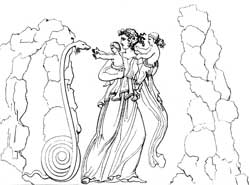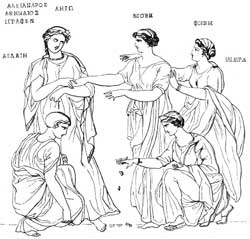Leto
In Latin Latona, according to Hesiod,1 a daughter of the Titan Coeus and Phoebe, a sister of Asteria, and the mother of Apollo and Artemis by Zeus, to whom she was married before Hera. Homer, who likewise calls her the mother of Apollo and Artemis by Zeus,2 mentions her as the friend of the Trojans in the war with the Greeks, and in the story of' Niobe, who paid so dearly for her conduct towards Leto.3

In later writers these elements of her story are variously worked out and embellished, for they do not describe her as the lawful wife of Zeus, but merely as a concubine, who was persecuted during her pregnancy by Hera.4 All the world being afraid of receiving her on account of Hera, she wandered about till she came to the island of Delos, which was then a floating island, and bore the name Asteria;5 but when Leto touched it, it suddenly stood still upon four pillars.6 According to Hyginus,7 Delos was previously called Ortygia, while Stephanus Byzantinus8 mentions a tradition, according to which Artemis was not born in Delos, but at Corissus. Servius9 relates the following legends: Zeus changed Leto into a quail (ὄρτυξ), and in this state she arrived in the floating island, which was hence called Ortygia; or, Zeus was enamored with Asteria, but she being metamorphosed, through her prayers, into a bird, flew across the sea; she was then changed into a rock, which, for a long time, lay under the surface of the sea; but, at the request of Leto, it rose and received Leto, who was pursued by Python. Leto then gave birth to Apollo, who slew Python.10
But notwithstanding the many discrepancies, especially in regard to the place where Leto gave birth to her children, most traditions agree in describing Delos as the place.11 After the birth of Apollo, his mother not being able to nurse him, Themis gave him nectar and ambrosia; and by his birth the island of Delos became sacred, so that henceforth it was not lawful for any human being to be born or to die on the island; and every pregnant woman was conveyed to the neighboring island of Rheneia, in order not to pollute Delos.12

We shall pass over the various speculations of modern writers respecting the origin and nature of this divinity, and shall mention only the most probable, according to which Leto is "the obscure" or "concealed," not as a physical power, but as a divinity yet quiescent and invisible, from whom is issued the visible divinity with all his splendor and brilliancy. This view is supported by the account of her genealogy given by Hesiod; and her whole legend seems to indicate nothing else but the issuing from darkness to light, and a return from the latter to the former.
Leto was generally worshiped only in conjunction with her children, as at Megara,13 at Argos,14 at Amphigeneia,15 in Lycia,16 near Lete in Macedonia,17 in a grove near Calynda in Caria,18 and other places.
❧
Iconography
Leto was portrayed with long hair and wearing a chiton, often with both her children on her arms, such as the Leto-group by Praxiteles (fourth century BCE). Furthermore on vases, coins, and reliefs, such as on the altar at Pergamon (second century BCE). The episode with the Lycian farmers was used in works by Bloemaert and Elsheimer.
References
Notes
- Theogony, 406, 921.
- Iliad i, 9, xiv, 327, xxi, 499, Odyssey xii, 318, 580.
- Iliad v, 447; xx, 40, 72; xxiv, 607; comp. xxi, 502; Odyssey xii, 580; Hymn to Apollo, 45 ff., 89 ff.
- Pseudo-Apollodorus. The Library i, 4.1; Callimachus. Hymn to Delos, 61 ff.; Scholiast on Euripides' Phoenician Women, 232 ff.; Hyginus. Fabulae, 140.
- Callimachus. Hymn to Artemis, 35, 37, 191.
- Pindar. Fragments Odes, 38; Strabo. Geography xii, p. 485.
- Fabulae, 93, 140.
- s.v. Κορισσός.
- on Aeneid iii, 72.
- Comp. Antoninus Liberalis, 35; Ovid. Metamorphoses vi, 370; Aristotle. History of Animals vi, 35; Athenaeus, xv, 701; Apollonius Rhodius. Argonautica ii, 707; Iamblichus. De Vita Pythagorica, 10; Strabo. Geography xiv, p. 639: in each of these passages we find the tradition modified in a particular way.
- Callimachus. Hymn to Apollo, init. 59; Hymn to Delos, 206, 261; Aeschylus. Eumenides, 9; Herodotus. Histories ii, 170.
- Strabo. Geography x, p. 486.
- Pausanias. Description of Greece i, 44.2.
- ii, 21.10.
- Strabo. Geography viii, p. 349.
- ibid. xiv, p. 665.
- Stephanus of Byzantium, s.v. Λήτη.
- Strabo. Geography xiv, p. 651.
Source
- Smith, William. (1870). Dictionary of Greek and Roman Biography and Mythology. London: Taylor, Walton, and Maberly.
This article incorporates text from Dictionary of Greek and Roman Biography and Mythology (1870) by William Smith, which is in the public domain.